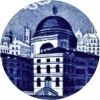Henshall & Co.
|
Henshall, Williamson & Co. A family affair
A map of 1802 shows that by that date there were five potteries at Longport, of which two were operated by companies that included members of the Williamson & Henshall families, the pottery at site 20 was listed as Henshall, Williamson & Co. and site 21 was listed as Williamson & Henshall.[vi] The families were all related by marriage; Hugh Henshall’s sister Jane was married to William Clowes, and his sister Anne Henshall first married James Brindley, and after his death in 1772, married Robert Williamson, with whom she had eight children. The oldest son of Robert and Anne Williamson was named Hugh Henshall Williamson and he married Anne Clowes. Not surprisingly this tangle of names has resulted in some confusion in understanding this company. The families were major landowners, wealthy from their canal engineering exploits, transport and haulage businesses, and investments in coal mines and other local industries. Pottery making was but one of their many interests.[vii] From 1805 into the 1820s various members of the Henshall and Williamson families joined and left the pottery company, one of their two factories was transferred to Davenport & Co. The second factory was retained and traded under the name of Henshall & Williamson.[viii] As Clowes & Co. the firm was noted for its black basalt wares and a number of examples survive in museum and private collections[ix] . In 1828, the local newspaper reported that a workman at the factory had been charged with theft of pottery made “solely for Havannah” and noted that Hugh Henshall Williamson employed between 500-700 workers with 60-80 of them being painters[x]. But perhaps the most prominent survivors of their manufacture are the blue printed patterns, which had a universal appeal. Marked examples usually carry a blue printed pattern name and occasionally are impressed Henshall & Co. The final reference to the firm is a notice of expiration of partnership. It was reported in August 1831 that on December 30, 1830, the earthenware manufacturing partnership between the two brothers, Hugh Henshall Williamson and Robert Williamson, had ended and that Robert Williamson would carry on alone and trade as Henshall & Williamson.[xi] However by the publication of the next local directory in 1834, the company was no longer listed.
[i] London Gazette December 12, 1780 [ii] Ward, John. 1843. The borough of Stoke-upon-Trent, … London: W. Lewis & Son: republished Webberley Ltd 1984, p.156 writes “The first manufactories at Longport were erected about the year 1773, by Mr. John Brindley... these were immediately followed by the erection of one by Mr. Edward Bourne, and in a short time afterwards, Mr. Robert Williamson erected another.” [iii] Edmundon R. “Staffordshire Potters Insured with the Salop Fire Office” Journal of the Northern Ceramic Society Vol.6 p.85 [iv] In January of 1800 Mrs. Anne Williamson of Long-port, Burslem insured a potworks, stock, utensils etc. and a house for a total of £1200 see Edmundon R. “Staffordshire Potters Insured with the Salop Fire Office” Journal of the Northern Ceramic Society Vol.6 p.88 [v] Chester & Mort. 1796. The Staffordshire Pottery Directory. Hanley & Newcastle, Chester & Mort; London Gazette November 14, 1800 [vi] Allbut, J. 1802. The Staffordshire pottery directory. To which is prefixed, an historical sketch of the country. And an account of the manufacture of earthenware. With a map. Hanley J Allbut and Son [vii] Family search.org; Ancestry.com; Skempton, A. W. 2002. A biographical dictionary of civil engineers in Great Britain and Ireland. Vol. 1, 1500-1830. London: Thomas Telford, pp. 316-319. [viii] Staffordshire Trade Directories and Burslem Land Tax Assessments [ix] Edwards, Diana. 1994, Black Basalt: Wedgwood and Contemporary Manufacturers, Antique Collectors Club, Woodbridge, 1994 [x] Staffordshire Advertiser, January 26, 1828, see Hampson, Rodney. 2000. Pottery References in the Staffordshire Advertiser 1795-1860. Kendal, Cumbria, Northern Ceramic Society. [xi] Staffordshire Advertiser, August 13, 1831, see Hampson, Rodney. 2000. Pottery References in the Staffordshire Advertiser 1795-1860. Kendal, Cumbria, Northern Ceramic Society. |
 1802 Map with Names of Manufactures   Blue printed plate, Henshall & Co.  Hargreaves map, 1832 showing the site of the Henshall potteries, the uppermost site became part of the adjacent Davenport factory.  portrait of Hugh Henshall Williamson |

 On several dates in May 1778, the London newspaper, The
Daily Advertiser, published classified advertisements for “Staffordshire Ware” to be sold by William Clowes & Co at 112 in the Minnaries (sic) or at their
Manufactory at Longport, near Burslem, Staffordshire. The partnership as Dealers in
China, Glass, and Earthen-Ware was dissolved in November 1780 with
William Clowes and Robert Williamson dealing with the outstanding accounts
On several dates in May 1778, the London newspaper, The
Daily Advertiser, published classified advertisements for “Staffordshire Ware” to be sold by William Clowes & Co at 112 in the Minnaries (sic) or at their
Manufactory at Longport, near Burslem, Staffordshire. The partnership as Dealers in
China, Glass, and Earthen-Ware was dissolved in November 1780 with
William Clowes and Robert Williamson dealing with the outstanding accounts